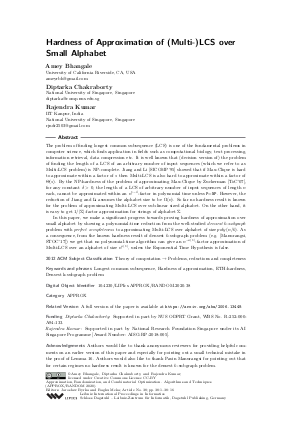@InProceedings{bhangale_et_al:LIPIcs.APPROX/RANDOM.2020.38,
author = {Bhangale, Amey and Chakraborty, Diptarka and Kumar, Rajendra},
title = {{Hardness of Approximation of (Multi-)LCS over Small Alphabet}},
booktitle = {Approximation, Randomization, and Combinatorial Optimization. Algorithms and Techniques (APPROX/RANDOM 2020)},
pages = {38:1--38:16},
series = {Leibniz International Proceedings in Informatics (LIPIcs)},
ISBN = {978-3-95977-164-1},
ISSN = {1868-8969},
year = {2020},
volume = {176},
editor = {Byrka, Jaros{\l}aw and Meka, Raghu},
publisher = {Schloss Dagstuhl -- Leibniz-Zentrum f{\"u}r Informatik},
address = {Dagstuhl, Germany},
URL = {https://drops.dagstuhl.de/entities/document/10.4230/LIPIcs.APPROX/RANDOM.2020.38},
URN = {urn:nbn:de:0030-drops-126418},
doi = {10.4230/LIPIcs.APPROX/RANDOM.2020.38},
annote = {Keywords: Longest common subsequence, Hardness of approximation, ETH-hardness, Densest k-subgraph problem}
}

 Creative Commons Attribution 3.0 Unported license
Creative Commons Attribution 3.0 Unported license































